Incorporating High-Speed Rail Development Scenario for Tourism Land Use Simulation: A Case Study of Xinxing County, China
Abstract
:1. Introduction
2. Literature Review
2.1. Land Use Change with Tourism Industry
2.2. Land Use Pattern with HSR Opening
2.3. Tourism Land Use Simulation
3. Methods
3.1. Study Framework
3.2. SD Model for Land Use Demand Projection
3.2.1. Economy Sector
3.2.2. Population Sector
3.2.3. Agricultural Production Sector
3.2.4. Tourism Industry Sector
3.3. PLUS for Land Use Changes Simulation
4. Study Area and Datasets
4.1. Study Area
4.2. Datasets
5. Results and Discussion
5.1. Model Validation
5.2. Future Tourism Land Use Changes Considering the Opening of HSR
5.2.1. Demand Projection and Spatial Simulation of Tourism Land
5.2.2. Spatial Distribution of Tourism Land Use Changes
5.2.3. Source of Tourism Land Use Transfer
5.3. Driving Force Analysis and Policy Implications
6. Conclusions
Author Contributions
Funding
Data Availability Statement
Conflicts of Interest
References
- UNWTO. Available online: https://www.unwto.org/ (accessed on 7 December 2021).
- Li, J.; Bai, Y.; Alatalo, J.M. Impacts of rural tourism-driven land use change on ecosystems services provision in Erhai Lake Basin, China. Ecosyst. Serv. 2020, 42, 101081. [Google Scholar] [CrossRef]
- Ning, G.; He, J. Study on Green Rural-Tourism in Undeveloped Western Region of China Under the Perspective of Urban-Rural Integration. AMR 2012, 518–523, 6075–6078. [Google Scholar] [CrossRef]
- Su, B. Rural Tourism in China. Tour. Manag. 2011, 32, 1438–1441. [Google Scholar] [CrossRef]
- Chen, K.; Long, H.; Liao, L.; Tu, S.; Li, T. Land Use Transitions and Urban-Rural Integrated Development: Theoretical Framework and China’s Evidence. Land Use Policy 2020, 92, 104465. [Google Scholar] [CrossRef]
- Liu, C.; Dou, X.; Li, J.; Cai, L.A. Analyzing Government Role in Rural Tourism Development: An Empirical Investigation from China. J. Rural Stud. 2020, 79, 177–188. [Google Scholar] [CrossRef]
- Yang, J.; Yang, R.; Chen, M.H.; Su, C.H.J.; Zhi, Y.; Xi, J. Effects of rural revitalization on rural tourism. J. Hosp. Tour. Manag. 2021, 47, 35–45. [Google Scholar] [CrossRef]
- National Development and Reform Commission (NDRC) People’s Republic of China. Available online: https://en.ndrc.gov.cn/ (accessed on 7 December 2021).
- Gössling, S. Global Environmental Consequences of Tourism. Glob. Environ. Change 2002, 12, 283–302. [Google Scholar] [CrossRef]
- Gössling, S.; Peeters, P. Assessing Tourism’s Global Environmental Impact 1900–2050. J. Sustain. Tour. 2015, 23, 639–659. [Google Scholar] [CrossRef]
- Xi, J.; Zhao, M.; Ge, Q.; Kong, Q. Changes in Land Use of a Village Driven by over 25 Years of Tourism: The Case of Gougezhuang Village, China. Land Use Policy 2014, 40, 119–130. [Google Scholar] [CrossRef]
- Dey, J.; Sakhre, S.; Gupta, V.; Vijay, R.; Pathak, S.; Biniwale, R.; Kumar, R. Geospatial Assessment of Tourism Impact on Land Environment of Dehradun, Uttarakhand, India. Env. Monit. Assess. 2018, 190, 181. [Google Scholar] [CrossRef]
- Yang, X.; Wang, J.; Sun, X.; Zhang, H.; Li, N.; Liu, J. Tourism Industry-Driven Changes in Land Use and Ecological Risk Assessment at Jiuzhaigou UNESCO World Heritage Site. J. Spat. Sci. 2018, 63, 341–358. [Google Scholar] [CrossRef]
- Shui, W.; Xu, G. Analysis of the Influential Factors for Changes to Land Use in China’s Xingwen Global Geopark against a Tourism Development Background. Geocarto Int. 2016, 31, 22–41. [Google Scholar] [CrossRef]
- Li, M.; Fang, L.; Huang, X.; Goh, C. A Spatial–Temporal Analysis of Hotels in Urban Tourism Destination. Int. J. Hosp. Manag. 2015, 45, 34–43. [Google Scholar] [CrossRef]
- Mao, X.; Meng, J.; Wang, Q. Tourism and land transformation: A case study of the Li River Basin, Guilin, China. J. Mt. Sci. 2014, 11, 1606–1619. [Google Scholar] [CrossRef]
- You, W.; Ji, Z.; Wu, L.; Deng, X.; Huang, D.; Chen, B.; Yu, J.; He, D. Modeling Changes in Land Use Patterns and Ecosystem Services to Explore a Potential Solution for Meeting the Management Needs of a Heritage Site at the Landscape Level. Ecol. Indic. 2017, 73, 68–78. [Google Scholar] [CrossRef]
- Ren, Y.; Lü, Y.; Comber, A.; Fu, B.; Harris, P.; Wu, L. Spatially Explicit Simulation of Land Use/Land Cover Changes: Current Coverage and Future Prospects. Earth-Sci. Rev. 2019, 190, 398–415. [Google Scholar] [CrossRef]
- Gomes, E.; Abrantes, P.; Banos, A.; Rocha, J. Modelling Future Land Use Scenarios Based on Farmers’ Intentions and a Cellular Automata Approach. Land Use Policy 2019, 85, 142–154. [Google Scholar] [CrossRef]
- Li, X.; Liu, X. An Extended Cellular Automaton Using Case-based Reasoning for Simulating Urban Development in a Large Complex Region. Int. J. Geogr. Inf. Sci. 2006, 20, 1109–1136. [Google Scholar] [CrossRef]
- Li, X.; Yeh, A.G.-O. Neural-Network-Based Cellular Automata for Simulating Multiple Land Use Changes Using GIS. Int. J. Geogr. Inf. Sci. 2002, 16, 323–343. [Google Scholar] [CrossRef]
- Mao, X.; Meng, J.; Wang, Q. Modeling the effects of tourism and land regulation on land-use change in tourist regions: A case study of the Lijiang River Basin in Guilin, China. Land Use Policy 2014, 41, 368–377. [Google Scholar] [CrossRef]
- Boavida-Portugal, I.; Rocha, J.; Ferreira, C.C. Exploring the impacts of future tourism development on land use/cover changes. Appl. Geogr. 2016, 77, 82–91. [Google Scholar] [CrossRef]
- Gao, Y.; Nan, Y.; Song, S. High-speed Rail and City Tourism: Evidence from Tencent Migration Big Data on Two Chinese Golden Weeks. Growth Change 2021, 53, 1012–1036. [Google Scholar] [CrossRef]
- Jin, S.; Yang, J.; Wang, E.; Liu, J. The Influence of High-Speed Rail on Ice–Snow Tourism in Northeastern China. Tour. Manag. 2020, 78, 104070. [Google Scholar] [CrossRef]
- Sun, Y.-Y.; Lin, Z.-W. Move Fast, Travel Slow: The Influence of High-Speed Rail on Tourism in Taiwan. J. Sustain. Tour. 2018, 26, 433–450. [Google Scholar] [CrossRef]
- Wang, D.; Niu, Y.; Qian, J. Evolution and Optimization of China’s Urban Tourism Spatial Structure: A High Speed Rail Perspective. Tour. Manag. 2018, 64, 218–232. [Google Scholar] [CrossRef]
- Chang, Z.; Zheng, L.; Yang, T.; Long, F. High-Speed Rail, New Town Development, and the Spatial Mismatch of Land Leases in China. Land Use Policy 2022, 115, 106014. [Google Scholar] [CrossRef]
- Niu, F.; Xin, Z.; Sun, D. Urban Land Use Effects of High-Speed Railway Network in China: A Spatial Spillover Perspective. Land Use Policy 2021, 105, 105417. [Google Scholar] [CrossRef]
- Zhang, H.; Li, X.; Liu, X.; Chen, Y.; Ou, J.; Niu, N.; Jin, Y.; Shi, H. Will the Development of a High-Speed Railway Have Impacts on Land Use Patterns in China? Ann. Am. Assoc. Geogr. 2019, 109, 979–1005. [Google Scholar] [CrossRef]
- Coyle, R.G. System Dynamics Modelling: A Practical Approach. J. Oper. Res. Soc. 1997, 48, 544. [Google Scholar] [CrossRef]
- Liang, X.; Guan, Q.; Clarke, K.C.; Liu, S.; Wang, B.; Yao, Y. Understanding the drivers of sustainable land expansion using a patch-generating land use simulation (PLUS) model: A case study in Wuhan, China. Comput. Environ. Urban Syst. 2021, 85, 101569. [Google Scholar] [CrossRef]
- Votsi, N.E.P.; Mazaris, A.D.; Kallimanis, A.S.; Pantis, J.D. Natural quiet: An additional feature reflecting green tourism development in conservation areas of Greece. Tour. Manag. Perspect. 2014, 11, 10–17. [Google Scholar] [CrossRef]
- Bahaire, T.; Elliott-White, M. The application of geographical information systems (GIS) in sustainable tourism planning: A review. J. Sustain. Tour. 1999, 7, 159–174. [Google Scholar] [CrossRef]
- Wang, J.; Liu, Y. Tourism-Led Land-Use Changes and Their Environmental Effects in the Southern Coastal Region of Hainan Island, China. J. Coast. Res. 2013, 290, 1118–1125. [Google Scholar] [CrossRef]
- Marzuki, A.; Masron, T.; Ismail, N. Land use changes analysis for Pantai Chenang, Langkawi using spatial patch analysis technique in relation to coastal tourism. Tour. Plan. Dev. 2016, 13, 154–167. [Google Scholar] [CrossRef]
- Ma, H.; Xi, J.; Wang, Q.; Liu, J.; Gong, Z. Spatial Complex Morphological Evolution and Influencing Factors for Mountain and Seaside Resort Tourism Destinations. Complexity 2020, 2020, 4137145. [Google Scholar] [CrossRef]
- Furgała-Selezniow, G.; Jankun-Woźnicka, M.; Kruk, M.; Omelan, A.A. Land use and land cover pattern as a measure of tourism impact on a lakeshore zone. Land 2021, 10, 787. [Google Scholar] [CrossRef]
- Petrov, L.O.; Lavalle, C.; Kasanko, M. Urban land use scenarios for a tourist region in Europe: Applying the MOLAND model to Algarve, Portugal. Landsc. Urban Plan. 2009, 92, 10–23. [Google Scholar] [CrossRef]
- He, D.; Chen, Z.; Pei, T.; Zhou, J. Analysis of structural evolution and its influencing factors of the high-speed railway network in China’s three urban agglomerations. Cities 2023, 132, 104063. [Google Scholar] [CrossRef]
- Chen, Z.; Zhou, Y.; Haynes, K.E. Change in land use structure in urban China: Does the development of high-speed rail make a difference. Land Use Policy 2021, 111, 104962. [Google Scholar] [CrossRef]
- Diao, M.; Zhu, Y.; Zhu, J. Intra-city access to inter-city transport nodes: The implications of high-speed-rail station locations for the urban development of Chinese cities. Urban Stud. 2017, 54, 2249–2267. [Google Scholar] [CrossRef]
- Wang, B.; Ersoy, A.; van Bueren, E.; de Jong, M. Rules for the governance of transport and land use integration in high-speed railway station areas in China: The case of Lanzhou. Urban Policy Res. 2022, 40, 122–141. [Google Scholar] [CrossRef]
- Basse, R.M. A constrained cellular automata model to simulate the potential effects of high-speed train stations on land-use dynamics in trans-border regions. J. Transp. Geogr. 2013, 32, 23–37. [Google Scholar] [CrossRef]
- Shen, Y.; Martinez, L.M.; de Abreu e Silva, J. Cellular agent-based approach incorporating spatial discrete choice methods: Simulation of future land use impacts of high-speed rail on Aveiro, Portugal. Transp. Res. Rec. 2014, 2430, 105–115. [Google Scholar] [CrossRef]
- Liang, X.; Liu, X.; Li, D.; Zhao, H.; Chen, G. Urban growth simulation by incorporating planning policies into a CA-based future land-use simulation model. Int. J. Geogr. Inf. Sci. 2018, 32, 2294–2316. [Google Scholar] [CrossRef]
- Shi, H.; Li, X.; Yang, Z.; Li, T.; Ren, Y.; Liu, T.; Yang, N.; Zhang, H.; Chen, G.; Liang, X. Tourism Land Use Simulation for Regional Tourism Planning Using POIs and Cellular Automata. Trans. GIS 2020, 24, 1119–1138. [Google Scholar] [CrossRef]
- Liu, J.; Wang, J.; Wang, S.; Wang, J.; Deng, G. Analysis and Simulation of the Spatiotemporal Evolution Pattern of Tourism Lands at the Natural World Heritage Site Jiuzhaigou, China. Habitat Int. 2018, 79, 74–88. [Google Scholar] [CrossRef]
- Al-Saad, S.A.; Jawarneh, R.N.; Aloudat, A.S. Spatiotemporal cluster analysis of reputable tourist accommodation in Greater Amman Municipality, Jordan. J. Hosp. Tour. Technol. 2023. [Google Scholar] [CrossRef]
- Beneki, C.; Spiggos, T. Spatial Patterns of Tourism Activity Through the Lens of TripAdvisor’s Online Restaurant Reviews: A Case Study from Corfu. In Culture and Tourism in a Smart, Globalized, and Sustainable World: 7th International Conference of IACuDiT, Hydra, Greece; Springer International Publishing: Cham, Switzerland, 2020; pp. 559–585. [Google Scholar]
- Liu, X.; Liang, X.; Li, X.; Xu, X.; Ou, J.; Chen, Y.; Li, S.; Wang, S.; Pei, F. A Future Land Use Simulation Model (FLUS) for Simulating Multiple Land Use Scenarios by Coupling Human and Natural Effects. Landsc. Urban Plan. 2017, 168, 94–116. [Google Scholar] [CrossRef]
- Gao, L.; Tao, F.; Liu, R.; Wang, Z.; Leng, H.; Zhou, T. Multi-scenario simulation and ecological risk analysis of land use based on the PLUS model: A case study of Nanjing. Sustain. Cities Soc. 2022, 85, 104055. [Google Scholar] [CrossRef]
- Lai, Z.; Chen, C.; Chen, J.; Wu, Z.; Wang, F.; Li, S. Multi-Scenario Simulation of Land-Use Change and Delineation of Urban Growth Boundaries in County Area: A Case Study of Xinxing County, Guangdong Province. Land 2022, 11, 1598. [Google Scholar] [CrossRef]
- Huang, Z.; Li, S.; Gao, F.; Wang, F.; Lin, J.; Tan, Z. Evaluating the Performance of LBSM Data to Estimate the Gross Domestic Product of China at Multiple Scales: A Comparison with NPP-VIIRS Nighttime Light Data. J. Clean. Prod. 2021, 328, 129558. [Google Scholar] [CrossRef]
- Chu, L.; Oloo, F.; Chen, B.; Xie, M.; Blaschke, T. Assessing the Influence of Tourism-Driven Activities on Environmental Variables on Hainan Island, China. Remote Sens. 2020, 12, 2813. [Google Scholar] [CrossRef]
- Gao, C.; Cheng, L. Tourism-driven rural spatial restructuring in the metropolitan fringe: An empirical observation. Land Use Policy 2020, 95, 104609. [Google Scholar] [CrossRef]
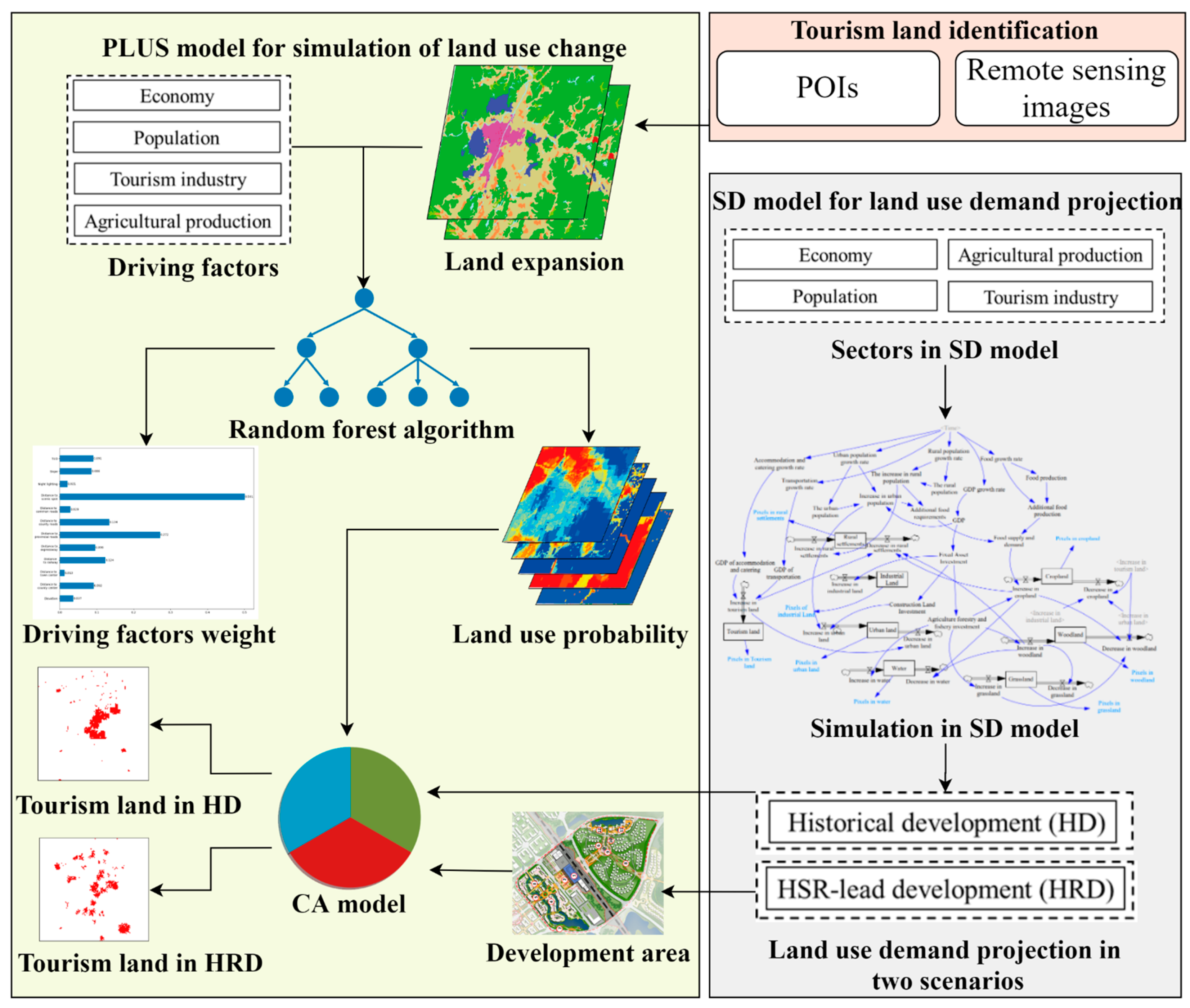
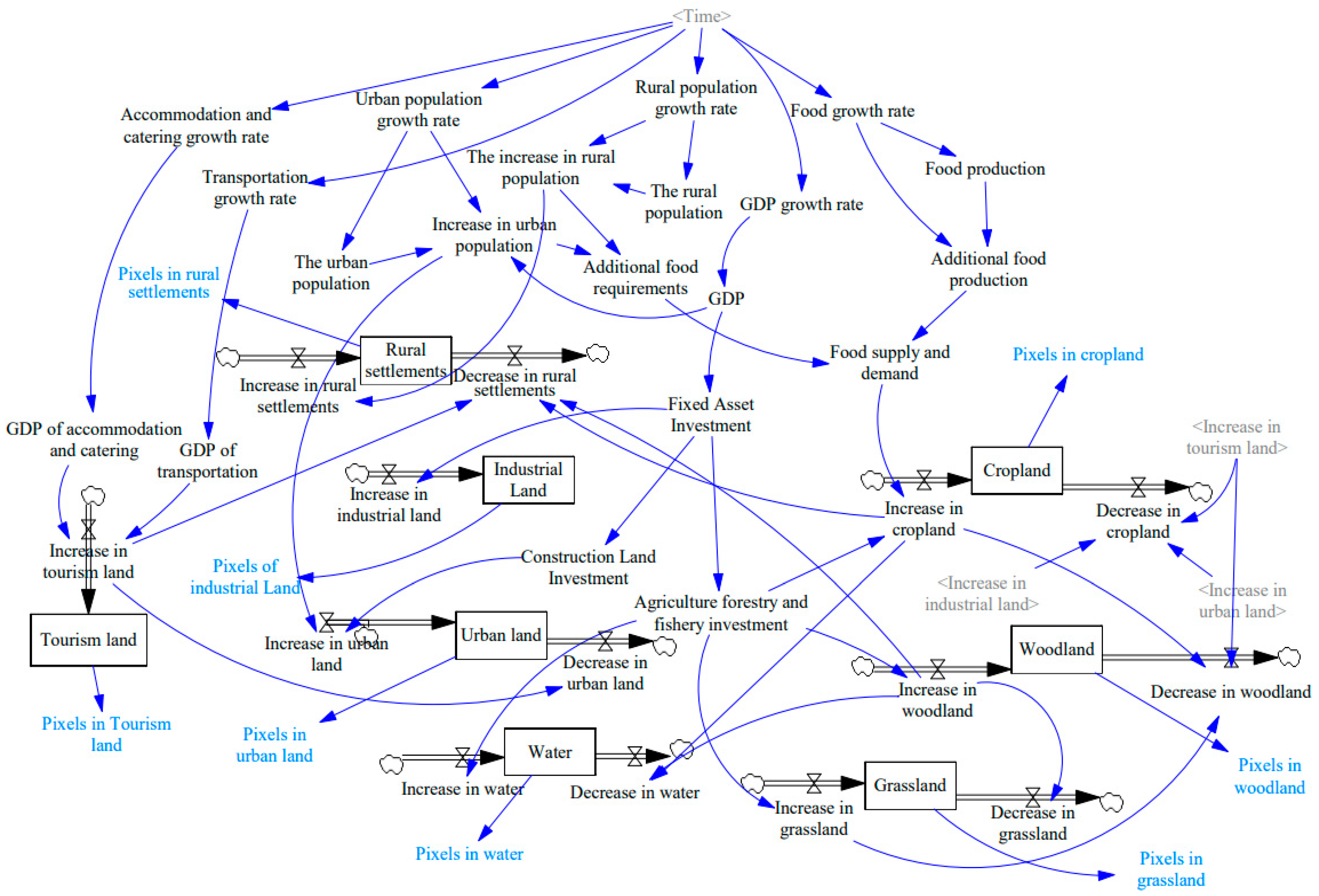
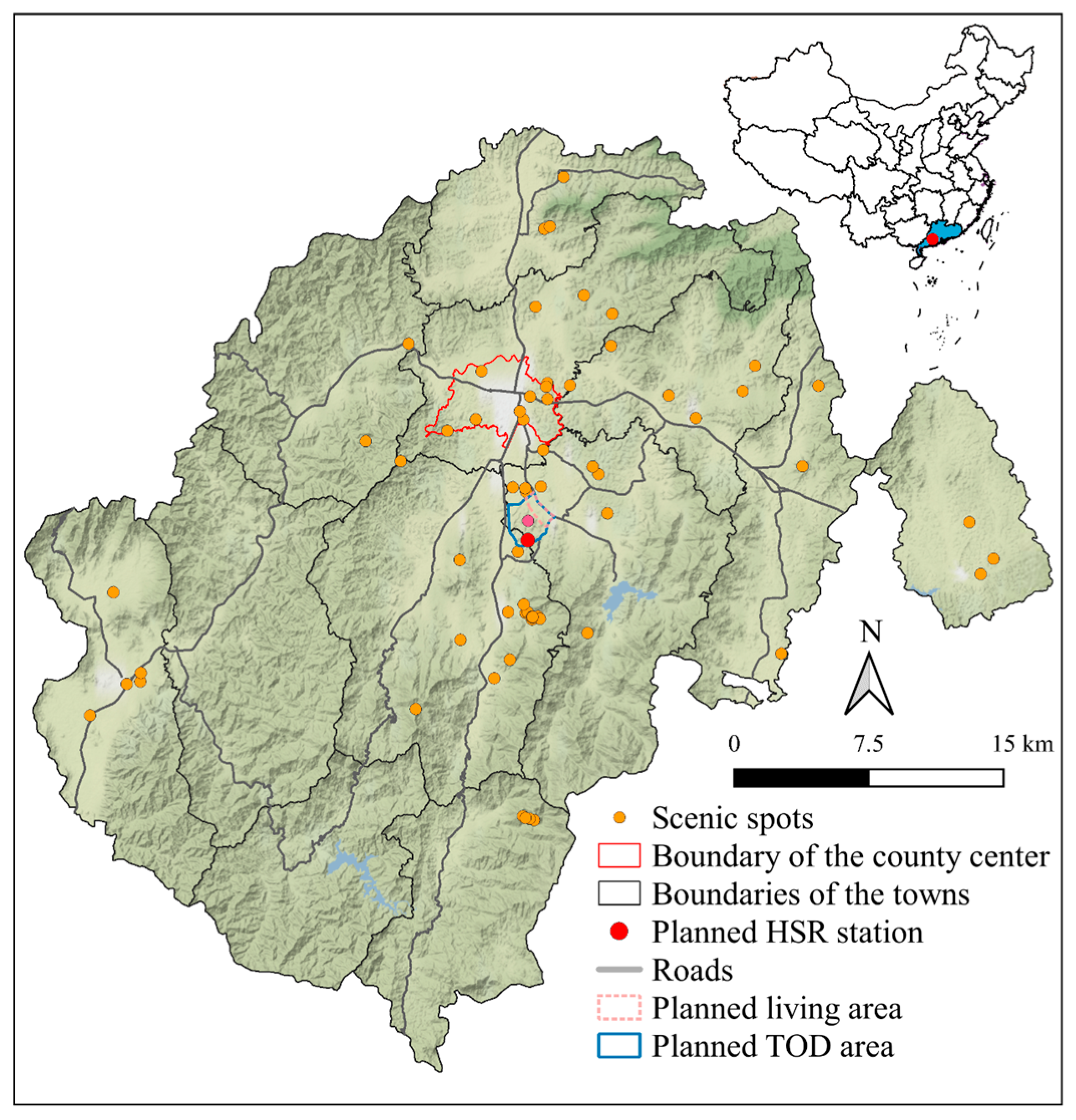
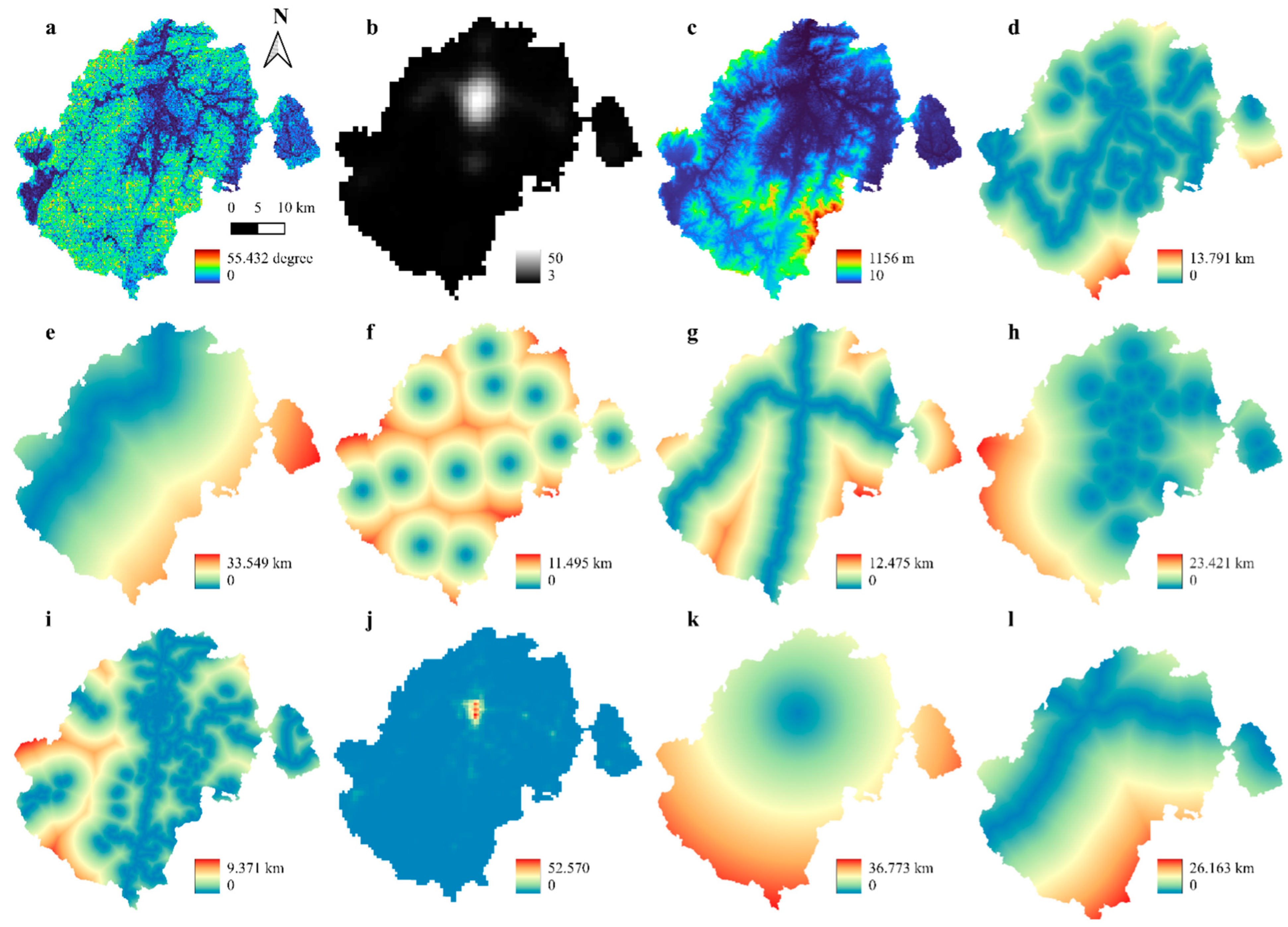


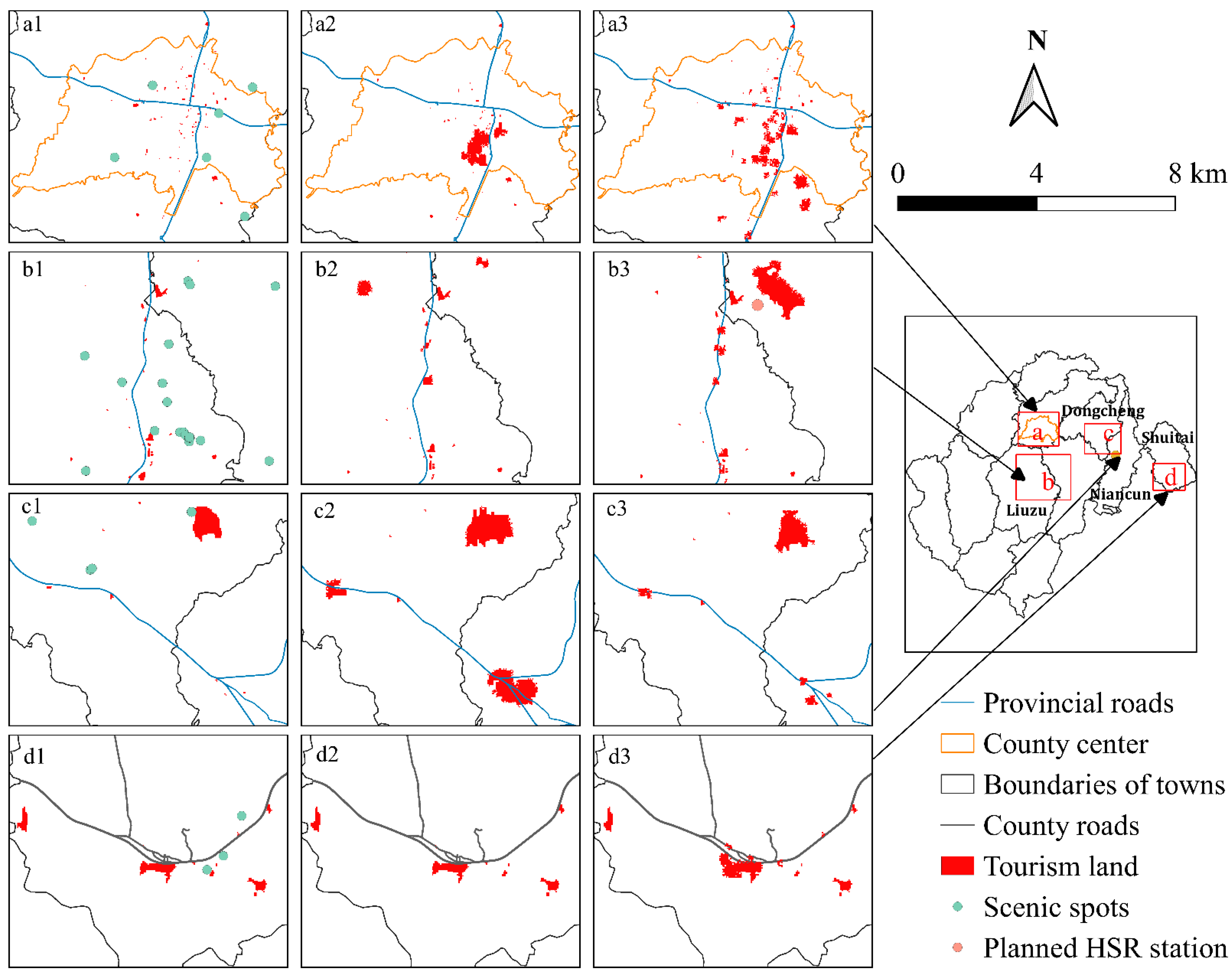
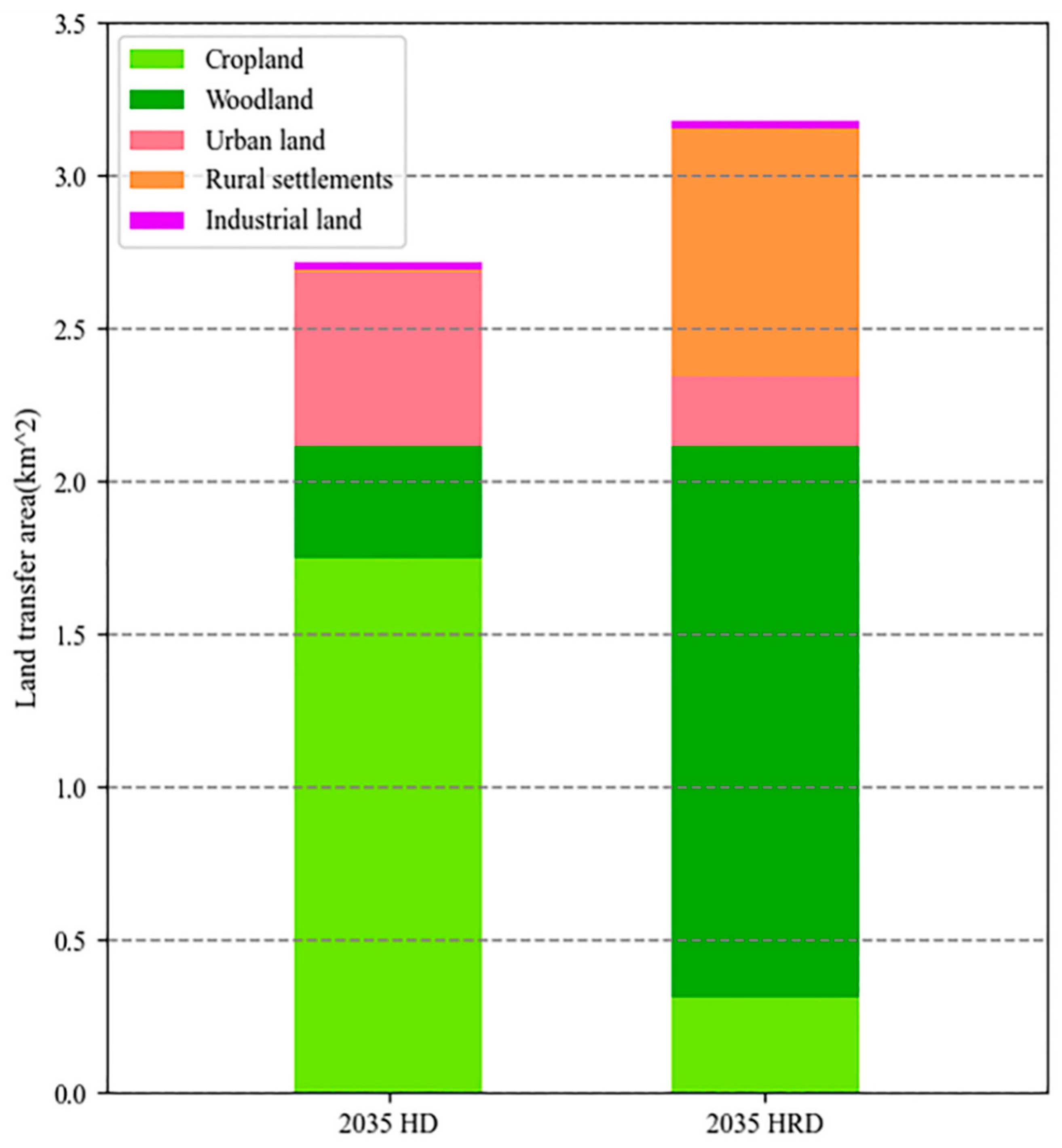
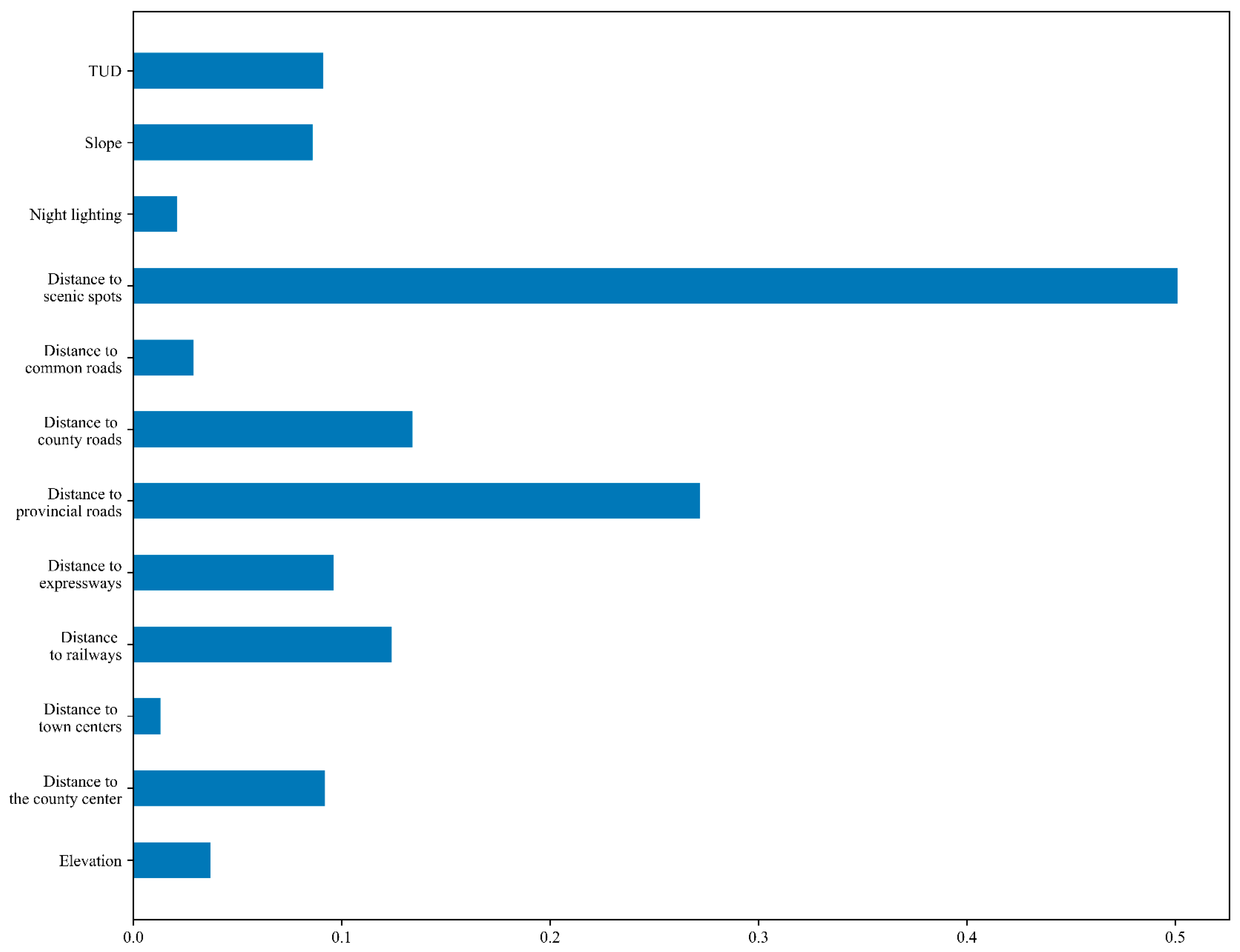
| Type | GGR | UPGR | RPGR | FGR | GACGR | GTGR | PCLI | PAFFI |
|---|---|---|---|---|---|---|---|---|
| HD | 9.8% | 2.5% | −0.11% | 0.171% | 11.2% | 6.0% | 6.0% | 2.7% |
| HRD | 10.5% | 2.7% | −0.05% | 0.175% | 14.1% | 7.2% | 6.5% | 2.9% |
| Category | Data | Year | Resolution | Source |
|---|---|---|---|---|
| Identification of tourism land | Satellite image | 2015 and 2019 | 4 m | Google Earth Pro |
| Tourism POIs | 2020 | / | Baidu Map | |
| Development area | Living area in planned TOD | 2020 | / | From Xinxing government |
| Distance to railways | 2019 | 30 m | ||
| Distance to provincial roads | 2019 | 30 m | ||
| Transportation factors | Distance to expressways | 2019 | 30 m | Authors’ calculation based on Amap |
| Distance to county roads | 2019 | 30 m | ||
| Distance to common roads | 2019 | 30 m | ||
| Distance to the county center | 2020 | 30 m | ||
| Location factors | Distance to scenic spots | 2020 | 30 m | Author’s calculation based on POI from Baidu Map |
| Distance to town centers | 2020 | 30 m | ||
| Human activities | Tencent user density (TUD) | 2019 | 500 m | https://cloud.tencent.com/solution/lbs |
| Night-time lighting | 2019 | 500 m | https://eogdata.mines.edu/download_dnb_composites.html | |
| Terrain factors | Elevation | 2019 | 30 m | |
| Slope | 2019 | 30 m | Calculation by slope analysis of elevation in QGIS3.16 |
| Land Use Types | Cropland | Woodland | Grassland | Water | Urban Land | Rural Settlement | Industrial Land | Tourism Land |
|---|---|---|---|---|---|---|---|---|
| Simulation | 363,781 | 1,138,377 | 52,437 | 28,083 | 18,752 | 55,037 | 30,806 | 2099 |
| reality | 365,118 | 1,136,803 | 53,241 | 27,949 | 18,094 | 54,184 | 30,907 | 2049 |
| Error (%) | −0.37% | 0.14% | −1.51% | 0.48% | 3.64% | 1.57% | −0.33% | 2.44% |
| Land Use Type | Cropland | Woodland | Grassland | Water | Urban Land | Rural Settlement | Industrial Land | Tourism Land |
|---|---|---|---|---|---|---|---|---|
| HD demand | 316.485 | 968.957 | 48.843 | 23.376 | 22.557 | 47.308 | 46.138 | 4.431 |
| change | −8.583 | −18.641 | 1.546 | −0.372 | 6.273 | −0.402 | 18.774 | 2.633 |
| HRD demand | 314.458 | 968.976 | 47.607 | 22.455 | 26.043 | 47.096 | 46.092 | 5.369 |
| change | −10.611 | −18.621 | −0.917 | −1.293 | 9.758 | −0.614 | 18.728 | 3.571 |
Disclaimer/Publisher’s Note: The statements, opinions and data contained in all publications are solely those of the individual author(s) and contributor(s) and not of MDPI and/or the editor(s). MDPI and/or the editor(s) disclaim responsibility for any injury to people or property resulting from any ideas, methods, instructions or products referred to in the content. |
© 2023 by the authors. Licensee MDPI, Basel, Switzerland. This article is an open access article distributed under the terms and conditions of the Creative Commons Attribution (CC BY) license (https://creativecommons.org/licenses/by/4.0/).
Share and Cite
Jiao, Z.; Li, S.; Lin, Z.; Lai, Z.; Wu, Z.; Liu, L. Incorporating High-Speed Rail Development Scenario for Tourism Land Use Simulation: A Case Study of Xinxing County, China. Land 2023, 12, 1170. https://doi.org/10.3390/land12061170
Jiao Z, Li S, Lin Z, Lai Z, Wu Z, Liu L. Incorporating High-Speed Rail Development Scenario for Tourism Land Use Simulation: A Case Study of Xinxing County, China. Land. 2023; 12(6):1170. https://doi.org/10.3390/land12061170
Chicago/Turabian StyleJiao, Zhenzhi, Shaoying Li, Zhangping Lin, Zhipeng Lai, Zhuo Wu, and Lin Liu. 2023. "Incorporating High-Speed Rail Development Scenario for Tourism Land Use Simulation: A Case Study of Xinxing County, China" Land 12, no. 6: 1170. https://doi.org/10.3390/land12061170







